You are here
Seth Interview with Mike Jozic, 2003
[The following is an interview with Seth by Mike Jozic, from January 2003. You can read the original here, hosted on Comics Bulletin. Thanks to Jason Sacks of Comics Bulletin for permision to reproduce the interview here.]
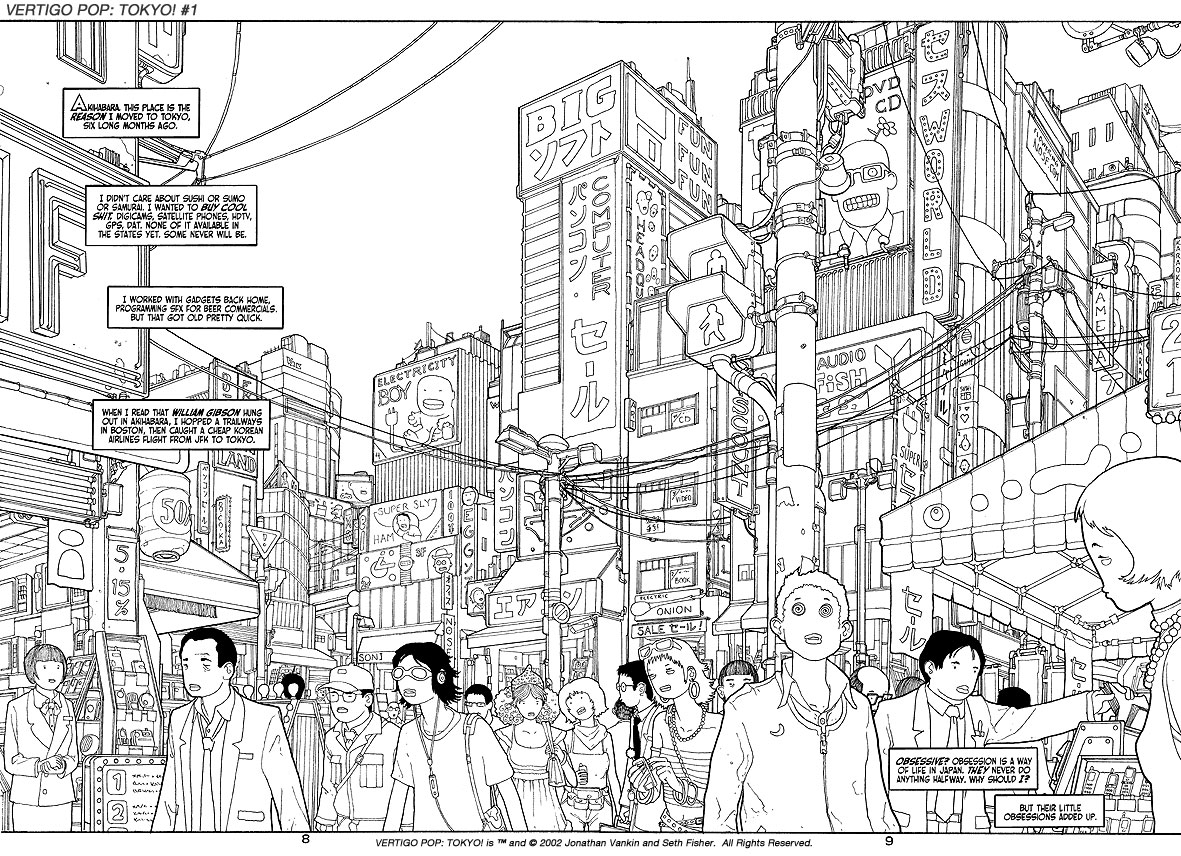
This is my second interview with the inimitable Seth Fisher and, as before, it was a pleasure and a privilege to do. Seth is one of the best e-mail interviews I’ve ever come across, and an incredibly giving person as far as time and convenience are concerned. And on top of all that, he is also an amazingly gifted artist, and if you don’t believe me, go check out his Vertigo Pop! Project, or his fill-in issue of Doom Patrol. Or better yet, just check out the images below and judge for yourself!
Anyway, since his Willworld graphic novel (the subject of our last interview), Seth has gone on to do some pretty amazing stuff in the field of comics. His Flash graphic novel with writer John Rozum, “Time Flies”, is a feast for the eyes, and his unique take on Tokyo for his last project of some length, is something that many western readers may not be accustomed to.
Always impressing in his work, and always pushing himself to bigger and better things, Seth Fisher is one of the most talented guys working in the industry today. It is a shame that he doesn’t do much in the way of monthly comics, but if high-profile projects are how he best keeps the quality of the work high, then I won’t mind the occasional wait between assignments.
So, sit back and I hope you enjoy this brief peek into the colourful mind of the talented Mr. Fisher. I certainly enjoyed putting it together.
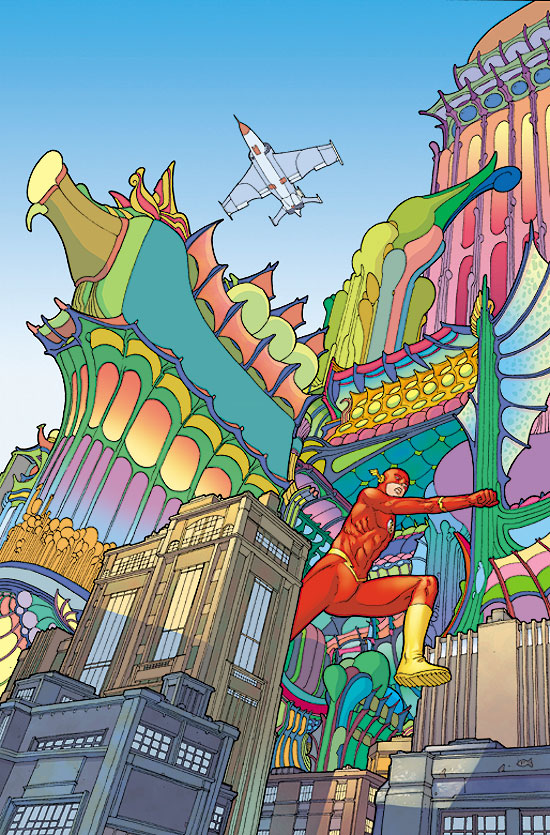 MIKE JOZIC: What appealed to you about the character of The Flash that made you want to work on this project?
MIKE JOZIC: What appealed to you about the character of The Flash that made you want to work on this project?
SETH FISHER: I don’t really have any investment in any particular super hero. I like them all the same, pretty much. This story was mostly a matter of timing (as most things end up being) as I was coming off of one project and anxious to get started on something else right away.
The thing that really appealed to me was a futuristic world where I could take a style of architecture that I created on one page in Willworld, and expand it into an entire book. I do like the Flash too, actually. I like the idea of simple powers: speed, invisibility, flight, etc. When a character’s powers get too complicated the character loses his edge, I think. A really fast guy - now there is a concept that is easy to grasp.
JOZIC: Was the project you were coming off of before Time Flies, Vertigo Pop: Tokyo?
FISHER: No, that was Willworld. We didn’t have a print date on Time Flies so we took our time getting everything together.
JOZIC: Judging from the copy on the DC site, Time Flies appears to be a lot more straightforward than Willworld, at least insofar as the plot goes. Was this a conscious decision, or just how the story had to be told?
FISHER: Well, the story had been written and waiting for an artist for almost a year, I think. Again, just timing. It was more straightforward, and plotted normal [in a] panel-to-panel style unlike Willworld, which was much more loose. After all, they didn’t know who would be drawing the book when it was written. I’m sure if John [Rozum] had known I was going to draw the book he would have tailored it to me.
But it’s not really important. I took the story and Seth-ized it through the art.
JOZIC: Did the story have to be tweaked at all for you, or did you pretty much work off of the original script as is?
FISHER: I think we changed a couple of lines because it didn’t make sense with the approach I took to the art, but it’s pretty close.
JOZIC: You did Willworld with J.M. DeMatteis, and now this project with John Rozum. Why the desire to collaborate rather than do the story as well as the art yourself?
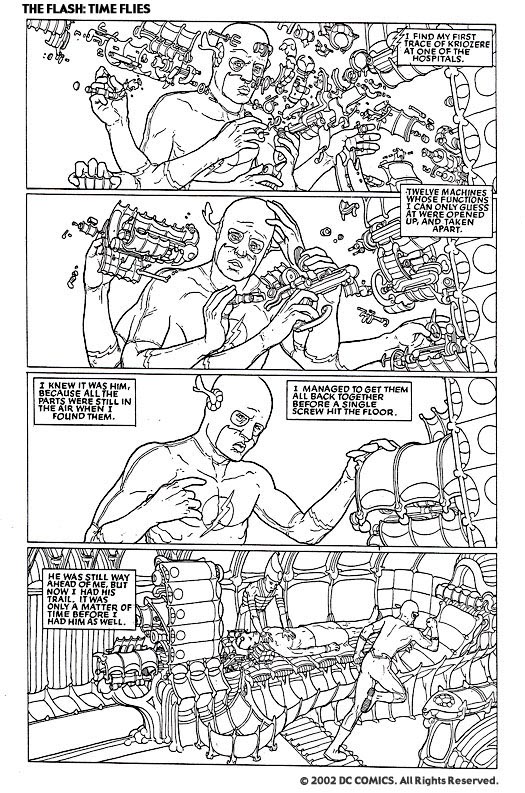 FISHER: I do plan to do some of my own stories in the future (and I mean the not too distant future), but there is a special edge that comes from collaboration, where the final product is more than any one person could have produced themselves. It lets me focus on the art and only the art. I really feel like the books I am doing these days are all training for something much bigger, but I don’t know what it is yet - perhaps it will be written by me.
FISHER: I do plan to do some of my own stories in the future (and I mean the not too distant future), but there is a special edge that comes from collaboration, where the final product is more than any one person could have produced themselves. It lets me focus on the art and only the art. I really feel like the books I am doing these days are all training for something much bigger, but I don’t know what it is yet - perhaps it will be written by me.
JOZIC: Were you familiar with John's work for other companies?
FISHER: I am familiar with Johns work. Like I said, the story was written before I was even offered the project, so I only talked to John about it a few times, whereas I talked to DeMatteis pretty regularly. It is a new way to work for me, but that’s a good thing too. Like I said, I am in training so any new skills are valued.
JOZIC: You seemed to have an enjoyable collaboration with DeMatteis on Willworld. Was your work with John equally satisfying?
FISHER: I was really freaked out about this book when I was drawing it. I really wanted to push myself in some unusual directions, but I wasn’t completely confident that every thing would come together. In fact, it wasn’t until sometime after I had finished the book that I really was able to appreciate how it all came together. You get too close to something, and it is very difficult to see it in its proper context. It’s like nothing I have done before, and that alone makes it worthwhile for me.
Also, it’s colored by Chris Chuckery, too (Willworld and Vertigo
Pop: Tokyo), and I always like that. I feel like working with Chris for so many pages, he really understands my sensibility, but at the same time, feels free to experiment and use the colors to really improve the story telling. He is a thinking man’s colorist and he doesn’t complain (at least not to me) about what a pain my pages are to color. I am always overjoyed to work with Chris.
JOZIC: Did you specifically request Chuckery to colour the books?
FISHER: Of course.
JOZIC: When you're playing around with your approach on each project, is this something that your editors are expecting, or do you run into problems sometimes selling them on the idea?
FISHER: Its kind of been the opposite. I am usually a little timid about doing something different. I mean, I have an idea that seems good and fresh and I want to do something new, but then I start to worry if it is really "Seth" and I get anxious. It’s my editors that see that new side and really encourage me to explore and promise me that they have my back if it all comes apart. I could never have drawn Willworld without Joey Cavalieri or Tokyo without Shelly Bond. They trust me more than I trust me. It takes me a long time to understand what is successful about a page I draw (like months) but my editors can figure it out in a few minutes.
JOZIC: I know you're not a big super-hero fan, but this is the second super-hero story you've done for DC. Do you have any plans to move to another character in he near future, putting your own unique visual spin on another of DC's icons?
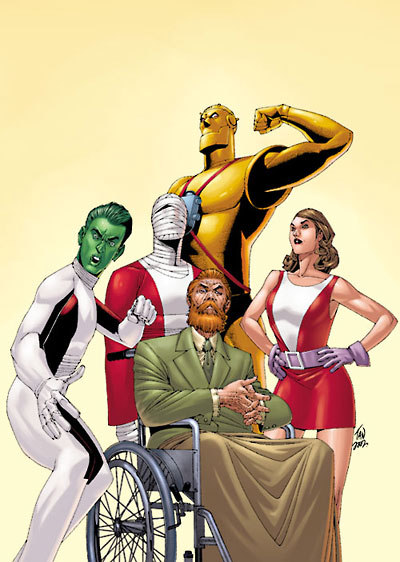 FISHER: I have some plans, but they are tentative at the moment. I wouldn’t want to tip my hand too soon then disappoint people. I am doing a couple fill-in issues for Doom Patrol for the winter (that’s a promise). There is some interesting stuff in there. I think DP is the best monthly at DC right now and Tan is probably my favorite artist in American comics now, too. I’m not sure if I can do it justice. I’ll try, but I certainly don’t want to go head to head with Tan. He is a monster with a pencil.
FISHER: I have some plans, but they are tentative at the moment. I wouldn’t want to tip my hand too soon then disappoint people. I am doing a couple fill-in issues for Doom Patrol for the winter (that’s a promise). There is some interesting stuff in there. I think DP is the best monthly at DC right now and Tan is probably my favorite artist in American comics now, too. I’m not sure if I can do it justice. I’ll try, but I certainly don’t want to go head to head with Tan. He is a monster with a pencil.
JOZIC: What aspects of what Arcudi and Tan are doing on Doom Patrol really appeal to you?
FISHER: Arcudi is a great writer in that he is really able to develop characters subtly over time and stay consistent. He thinks in terms of long-term story telling, but keeps the book in movement at the same time. Tan’s art just kicks ass. He is so accurate and at the same time so playful and willing to exaggerate. I have learned a ton looking at Tan’s work. I’m sorry the book isn’t selling more, but I don’t think Tan has anything to worry about, he will be recognized as one of the top artists in the field pretty shortly.
He’s just too good not to be.
JOZIC: When you choose a hero (or group) that you want to tackle, do you try and keep your style in mind and whether or not it is appropriate for that particular character, or do you take that opportunity to tell a story that hasn't been done before in a style people are not used to?
FISHER: The point is never just to screw with your expectations. That’s just a by-product of creating something new. I always consider the style and how it relates to the character and the story. For VP Tokyo I chose a style that felt like it was somewhere in-between Japanese manga and American comics because it seemed appropriate to tell a story about Japan using some of the same idioms the Japanese use. The cuteness of a Japanese school girl needed to be conveyed through the same sensibilities of "cute" that Japanese people understand. Frankly, my Japanese friends didn’t think any of my Willworld characters were very cute (just weird), so I had to search for a middle ground.
JOZIC: The last time I interviewed you, you didn't want to tell me what the original pitch for Willworld was because you had plans to use it on another project. Any chance you would spill the beans on it now?
FISHER: No, but you’re welcome to keep trying.
JOZIC: You once said that you hope to learn something from every project you do, adding a new element or technique every time. Was that the case with Time Flies?
FISHER: Of course! In Time Flies careful readers will notice that in all the future scenes (which is almost the entire book) I drew every single panel in curved perspective. Now, the architecture is all Gaudi-ish and crazy so it’s easy to miss, but I think I prefer it subtle anyway. Normally I work in pretty heavily grounded perspective, but this book really gave me a chance to try stuff I have never had the nerve to do before with all kinds of different curves and depths to the perspective. I learned a lot from that.
 JOZIC: You say that Gaudi was an influence on the architecture of Time Flies' futurescape, what other influences outside of the comics industry do you draw on for your work?
JOZIC: You say that Gaudi was an influence on the architecture of Time Flies' futurescape, what other influences outside of the comics industry do you draw on for your work?
FISHER: I try to pull out all the stops when I attack a book which means that the best ideas I can think of at the time go on paper. I know some guys who tend to keep their really good ideas for their personal projects, which I can sympathize with, but I find it too depressing to put down my second best idea and put the best one in a drawer. What that means is that everything interesting or important in my life gets translated to my art somehow. I don’t feel the need to study art history or look for styles, they find me. I happen to be a big fan of Gaudi, so naturally it gets worked into my art. I happen to have a bald head, and you know what happened in Willworld. I love Japan, so a lot of that gets translated into art too. It’s too hard to pin down one thing. My artwork is just like a foot print of my experiences.
JOZIC: A lot of creators like to throw in a bit of science fact when dealing with the Flash and his speed powers. With your academic background and the time travelling nature of Time Flies, did anything of that nature sneak into this story while you were working on it?
FISHER: Well, whenever you have a time travel story you almost always create plot holes that will never agree with a math major`s sensibility, so it’s more a matter of reminding myself it is just a comic book and trying to really have fun with it.
JOZIC: How long did Time Flies take to complete, from the beginning of your involvement to the end?
FISHER: Well, I think I started it last April 2001, and I finished the cover maybe in February or March [of] 2002. It wasn’t that the pages took me so long to draw, just that I was juggling 3 projects at the same time and this one had no deadlines, so we had the liberty to take it easy.
JOZIC: How would you compare the Flash story with your Vertigo Pop book? Is it a complete 180 degrees in approach, or are the differences mostly in content and characters?
FISHER: Its at least 180 degrees. More like separate worlds. I wont even try to contrast them, it will just sound silly after you pick up the two books and wonder if they are drawn by the same guy.
It’s really easy to get stuck parodying yourself. I know because it happens to me all the time. That’s why I try to pick radically different projects to work on so that I will have to totally rebuild my strategy from the ground up. It keeps me learning how to draw and learning how to tell a better story. I always run the risk of totally f#$"ing up and making a really crappy book by trying to re-invent myself all the time, but I guess I have been lucky so far.
There is tons of stuff I would change in every book I have done, but after the book is done you have to look at it for what it is and ask yourself, “do I really want a whole box of comp copies of this book?” So far, I have been able to answer yes to that question, but I might trip up somewhere sometime. If I do, please smack me around until I start to draw properly again.
JOZIC: On Willworld, you mentioned that you had done some touch ups late in the process after seeing what the finished pages were going to look like. Did you have any of that going on with Time Flies or Vertigo Pop: Tokyo?
FISHER: Oh sure, the page is always a work in progress until it goes to press. We tweak stuff up until days before the final deadline a lot of times. My pencils have become a lot tighter since Willworld though, so I don’t think I am doing the kind of radical changes that I was doing there. Also, all the stuff I do from Tokyo is paste up lettering, so I don’t get a chance to tweak the art after I see the letters. I have to get them to tweak the letters instead (and I do).
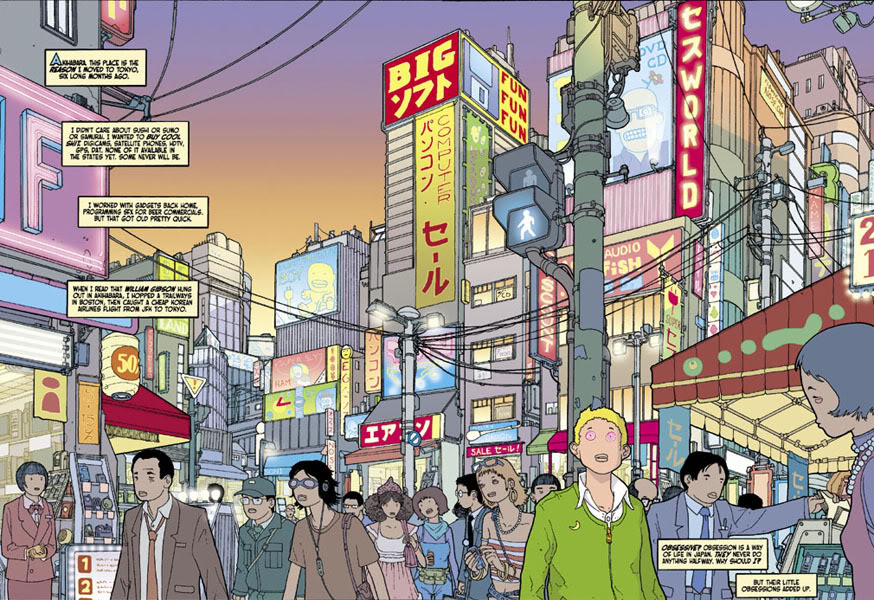 JOZIC: You actually lived in Japan, did you not? Was that a great help in designing the setting and characters for the story?
JOZIC: You actually lived in Japan, did you not? Was that a great help in designing the setting and characters for the story?
FISHER: I am still living in Japan, actually. I lived here for four years back before I started working in comics, and then I finally moved back here very recently to help me get the right feel for this book. This book is by far the most personal work I have made to date and it is very important to me that it be as good as it can be. The story is totally fiction, but the important part is capturing what it feels like to be a Gaijin in Japan. Jon Vankin, the writer actually made a couple trips to Japan to help him with the book, too (he lived here for several years). I think it’s as close to authentic as I’ll be able to come for a while.
JOZIC: You actually moved back to Japan to get the right feel for the book? Kind of expensive research, isn’t it?
FISHER: Maybe, but Tokyo is where I want to be anyway, so it worked out nicely. Besides, this is by far the most personal work I have ever done and it was important for me to make it as good as I possibly could make it. I needed this book to be my best work.
JOZIC: What do you think would have been different about the book had you been in the U.S. while drawing it?
FISHER: I’m not sure. Half of the book was actually drawn while I was in the US, though I did those layouts when I was in Tokyo. Maybe you can just compare issues 1 and 2 to issues 3 and 4 to see the answer. I took about 30 rolls of film too to make sure I had enough reference to go on. I used that to get the details right when I was drawing the first two books in the US. I sort of solve my problems as I go so it’s hard to guess where I would have gone under different circumstances.
JOZIC: You said that it seemed appropriate to tell a story about Japan using some of the same idioms the Japanese use. What sorts of things were you being particularly conscious of in your drawings?
FISHER: Well for the most part, it is an aesthetic [that] I am concerned about. Japanese have a sense of cute that is very refined. They can find cuteness in Salarymen, and in sushi, as well as in kittens and puppys.
JOZIC: The background detail in VP: Tokyo! seems to be a little bit less than what we’ve become accustomed to seeing from your work. Was that another conscious decision for this particular book, or is your style just gravitating towards a simpler look?
FISHER: When I did the book, I was worried [about] how I could approach Tokyo without being overly affected by Geoff Darrow’s great work on Big Guy and
Rusty. I needed an approach that was true to the city, but still allowed me to focus on the characters. I am trying very hard to simplify my style and I am still finding that balance. In the end, characters make the story and I couldn’t let the city outshine the characters. The characters are really simple, so I felt like I needed to cut back a little on the backgrounds. It sounds easy, but for me that simplicity is much harder than just cramming in a lot of detail. I think, for me, a good simple composition takes me longer than just drawing until the page is full.
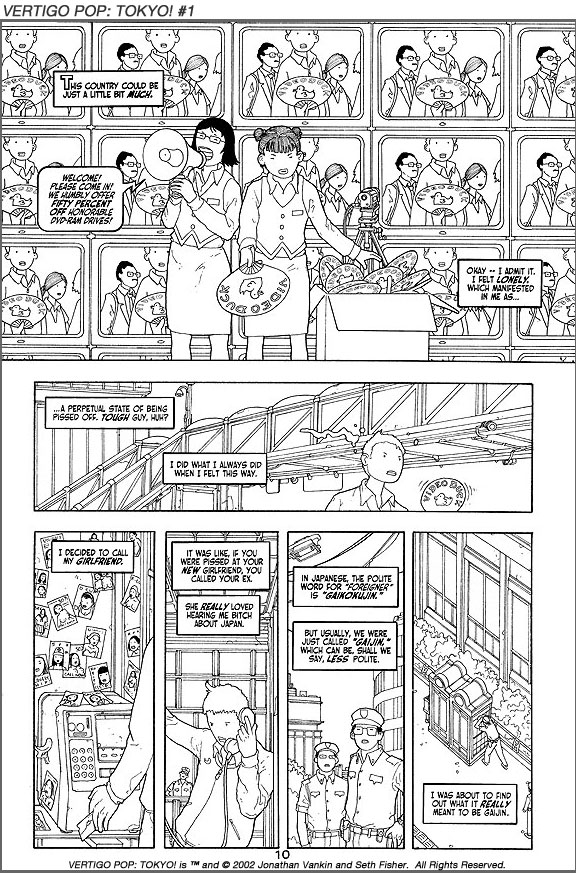 JOZIC: How would you describe the Japanese “scene” from a Gaijin’s point of view? Or would that just be repeating the whole point of the mini-series?
JOZIC: How would you describe the Japanese “scene” from a Gaijin’s point of view? Or would that just be repeating the whole point of the mini-series?
FISHER: Well, this book is Japan told from mine and Jonathan’s (gaijin) point of view, so that is part of it. I don’t like to really over analyse Japan if I can help it because it is something that really has to be experienced to be understood. The book is the closest thing I can come up with now so I’ll leave it at that.
JOZIC: You and John both probably have a little bit of Steve in you, but how much of the story was based on your own Japanese experience, and how much was based on John’s?
FISHER: Some of the scenes are based on very real events, while others are exaggerated and others are, thankfully, completely fictional. I would say that the Steve character is closer to Johns experience since he was writing it, but the actual feeling for Japan and the things that are hypnotic about it are from my POV since I was picking and choosing the settings quite a bit. The book only really just starts to show how weird things can get there though.
JOZIC: Have you had any response on the book from your Japanese friends?
FISHER: They are all really positive. They are my friends though, so they kinda have to say nice things. I think the books are selling out in the few shops in Tokyo where they are sold, but I don’t know if those are Japanese buying them or Americans.
JOZIC: I read that you had actually toned down some of your depictions of Japanese culture because they wouldn’t be believable to a Western audience. What sorts of things did you leave out?
FISHER: You see these restaurants with a two story fully animatronic crab waving its arms, or a side street that is so densely packed with electric wires that you can stay cool it its shadow. Kids that have afros that couldn’t fit in a dryer or these cars that are so decked out they look like something from a sci-fi movie. It would look like a circus if I really went with the far out details that make up Japan. It’s true, but it would read like a farce.
JOZIC: What is your favourite aspect of Japanese culture? Are you a gadget geek like Steve, or is there something else that grabs your imagination?
FISHER: I like Japanese people. They have their hang-ups but being around Japanese people helps me lose my cynicism. They give me a fresh perspective on my own life.
JOZIC: What would you say is the West’s biggest misconception of life on that end of the Pacific?
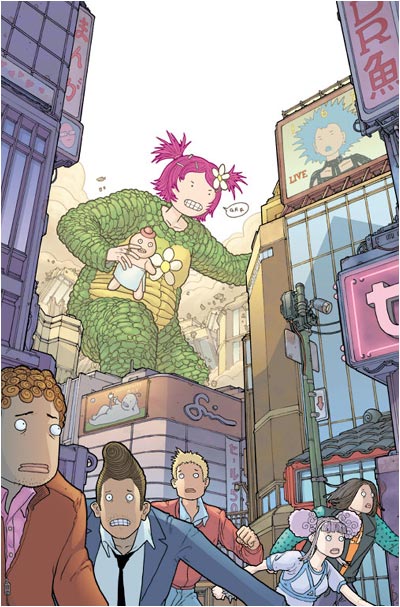 FISHER: Well I think most people think that Japan is like Tokyo. Japan is mostly small towns and trees and rice fields and mountains. There are just a few big cities where a lot of people congregate.
FISHER: Well I think most people think that Japan is like Tokyo. Japan is mostly small towns and trees and rice fields and mountains. There are just a few big cities where a lot of people congregate.
JOZIC: On an altogether different note, after being freelance for so long, is it kind of weird to be exclusive to DC, or is it a kind of relief to have that security?
FISHER: I like DC and I like my editors and I have too much work with DC to really think about doing other stuff, so an exclusive [is] pretty natural. I still feel like a freelancer.
JOZIC: What do you hope to accomplish in that year or two of exclusivity?
FISHER: I just want to make books that haven’t been made and see what I am capable of. The exclusive is really secondary to my goals. There is no plan, exactly. Just a feeling for what possibilities exist, and a desire to try to push my limits.
| Mike Jozic has spent the last several years interviewing comic book creators and other entertainment related personalities for various publications. He has been published both online and in print, with his work appearing in The Comics Journal, FearsMag.com and Silver Bullet Comicbooks. He maintains his own website at www.meanwhile.net and currently serves as the Features Editor for SBC. |
- Log in to post comments







